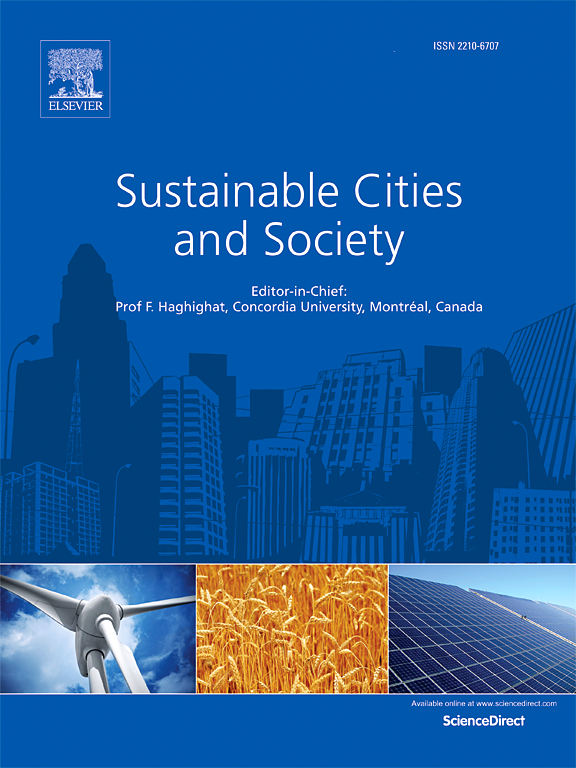光伏-绿化系统热行为的实验与模型研究
IF 10.5
1区 工程技术
Q1 CONSTRUCTION & BUILDING TECHNOLOGY
引用次数: 0
摘要
光伏与绿化的结合(PVG系统)在城市中越来越受到关注。然而,PVG体系的热行为特征尚未完全揭示。为此,进行了PVG系统与草坪的局部小气候对比试验。结果表明:光伏阵列白天对下方植被降温高达2.5℃,夜间对植被升温高达0.7℃;能量平衡分析表明,在PV遮阳作用下,蒸散发消耗的热量约占总热量的43.8%,其次是长波辐射(29.5%)和热对流(26.7%)。建立了考虑植被与光伏组件之间多重热相互作用的数值模型,并通过实测数据进行了验证。通过参数分析发现,PVG系统以高等植物种类为主,降温效果优于草坪。场景仿真表明,在现有的PVG系统传热模型中,通常忽略的四个因素中,长波辐射导致的误差最为显著。所得结论可为PVG系统的设计优化和能量性能预测提供参考。本文章由计算机程序翻译,如有差异,请以英文原文为准。
An experimental and modeling study of thermal behavior of photovoltaic-greenery system
The combination of photovoltaic and greenery (PVG system) has received increasing attention in the city. However, the characteristic of thermal behavior for PVG system has not been fully revealed. Therefore, a field experiment was carried out to compare the local microclimate between PVG system and a lawn. And the results show that PV array cooled the below vegetation up to 2.5 °C in the daytime, but warmed the vegetation up to 0.7 °C at night. Energy balance analysis shows that, under the effect of PV shading, evapotranspiration consumed about 43.8 % of the total heat gain, and followed by longwave radiation (29.5 %) and heat convection (26.7 %). A numerical model considering the multiple thermal interactions between vegetation and PV modules was developed and validated by the measured data. Based on the parametric analysis, it’s found that higher plant species is preferred for PVG system, which has a greater cooling effect than the lawn. And a scenario simulation shows that, among the four factors usually neglected in the existing heat transfer model of PVG system, longwave radiation leads to the most significant error. The conclusions drawn herein could provide reference for the design optimization and energy performance prediction of PVG system.
求助全文
通过发布文献求助,成功后即可免费获取论文全文。
去求助
来源期刊

Sustainable Cities and Society
Social Sciences-Geography, Planning and Development
CiteScore
22.00
自引率
13.70%
发文量
810
审稿时长
27 days
期刊介绍:
Sustainable Cities and Society (SCS) is an international journal that focuses on fundamental and applied research to promote environmentally sustainable and socially resilient cities. The journal welcomes cross-cutting, multi-disciplinary research in various areas, including:
1. Smart cities and resilient environments;
2. Alternative/clean energy sources, energy distribution, distributed energy generation, and energy demand reduction/management;
3. Monitoring and improving air quality in built environment and cities (e.g., healthy built environment and air quality management);
4. Energy efficient, low/zero carbon, and green buildings/communities;
5. Climate change mitigation and adaptation in urban environments;
6. Green infrastructure and BMPs;
7. Environmental Footprint accounting and management;
8. Urban agriculture and forestry;
9. ICT, smart grid and intelligent infrastructure;
10. Urban design/planning, regulations, legislation, certification, economics, and policy;
11. Social aspects, impacts and resiliency of cities;
12. Behavior monitoring, analysis and change within urban communities;
13. Health monitoring and improvement;
14. Nexus issues related to sustainable cities and societies;
15. Smart city governance;
16. Decision Support Systems for trade-off and uncertainty analysis for improved management of cities and society;
17. Big data, machine learning, and artificial intelligence applications and case studies;
18. Critical infrastructure protection, including security, privacy, forensics, and reliability issues of cyber-physical systems.
19. Water footprint reduction and urban water distribution, harvesting, treatment, reuse and management;
20. Waste reduction and recycling;
21. Wastewater collection, treatment and recycling;
22. Smart, clean and healthy transportation systems and infrastructure;
 求助内容:
求助内容: 应助结果提醒方式:
应助结果提醒方式:


